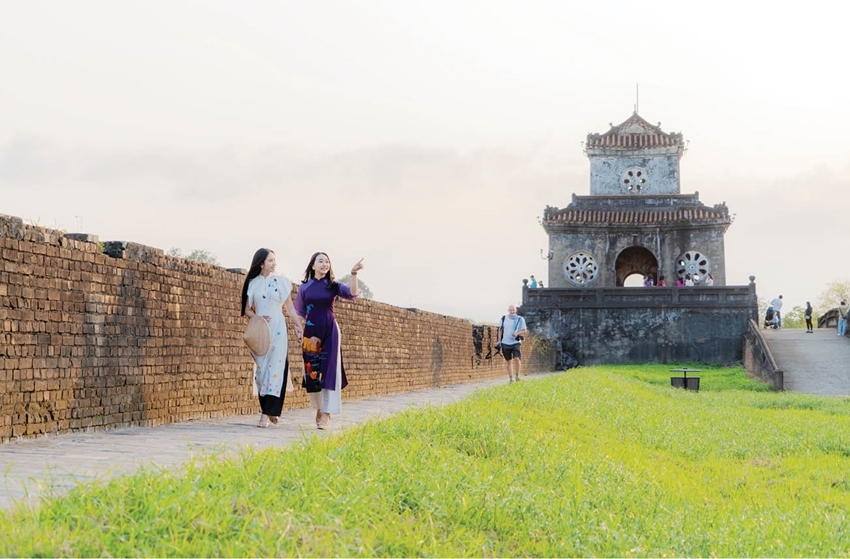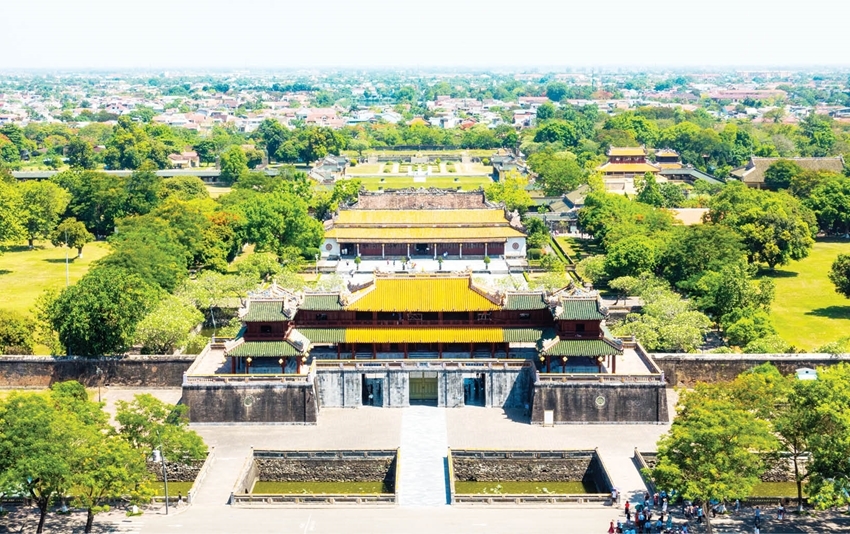    |
 |
| Walking route on the Thượng Thành (Wall upper-surface of the Citadel). Photo: Hue Monuments Conservation Center |
Embellishing monuments with efforts
In 2018, the Project of Population Relocation and Site Clearing for the Zone I of the Hue Citadel was approved by the Prime Minister for the policy framework on compensation, support and resettlement for relocation and settlement of the population, and Site clearance in the zone I of Hue Citadel relic.
The project has implemented phase 1, completed relocation of over 5,000 households, and built a resettlement area for people living on parts of Hue Citadel relic, including Thuong Thanh, Eo Bau sites, Ho Thanh hao (the protective moat surrounding the Citadel). Currently, the project is implementing phase 2, completing the relocation of about 1,000 households and building resettlement for residents from the relics of Tinh Tam Lake, Hoc Hai Lake, Xa Tac Esplanade, Kham Thien Giam, Xien Vo Tu, Luc Bo, the lake system of the 4 wards in the Citadel and Tran Binh Dai relic.
After completing the phase 2, the relocation of households from the relic is basically completed. This is a great effort of the authorities at all levels to return the appearance of Hue relics.
After nearly 200 years of existence with many historical and time events, Thai Hoa Palace - the most important palace in the Imperial Citadel of Hue, was seriously degraded. With the timely attention of the Government, ministries, central branches and Provincial People's Committee, the project of overall conservation and restoration of Thai Hoa palace monument was started at the end of 2021 with a total investment of over 128 billion dongs.
With the importance and value of Thai Hoa Palace, Hue Monuments Conservation Center together with the construction partner are determined to carry out the restoration work with the highest quality and ensure its authenticity. Currently, the project has completed the installation of the wooden structure system and will proceed to build and decorate the roof edges and roof tiles this year. Its completion is expected in early 2025.
Mr. Ho Huu Hanh, Director of Hue Monuments Restoration Joint Stock Company - the construction unit, said: “Thai Hoa Palace is an important relic, so the construction unit is very careful during the restoration process. All missions are conducted according to approved procedures. The work is closely monitored, with the advice of the scientific council during the restoration process, especially the technical decoration details and construction solutions.”
Not only in Thai Hoa Palace, this approach is applied by Hue Monuments Conservation Center in all other monument restoration works to ensure scientific and truthfulness, with the ultimate aim of ensuring elements to honor the value of monuments.
    |
 |
| The monuments are conserved, embellished and basically restored their appearance. Photo: Hue Monuments Conservation Center |
Reviving heritage
According to the evaluation document of Hue monuments system in 1990, Hue monuments, at their most complete condition, had a total of 850 architectural works, but only 460 works remained. Other monuments have ruined and 80% of the relics were in urgent need of restoration.
Facing that situation, the Government made efforts to promote the conservation and restoration of relics. The Government approved the Plan for preserving and promoting the value of Hue monuments in the period of 1996-2010, with a total investment of 720 billion dongs to preserve, conserve and restore more than 80 major works. Then, it approved the adjustment of the Plan in the 2010-2020 of period, with a total investment of more than 2,300 billion dongs to preserve, conserve, restore and embellish more than 171 works and items.
After 30 years since the Complex of Hue Monuments was recognized by UNESCO as a World Cultural Heritage, with the attention of the Party, State, Government and the effective support of the international community, the relic conservation task has achieved many proud results with 200 works and items preserved, conserved and restored. The complex is now in the stage of stability, development and value promotion. Hue cultural heritage is gradually being revived. The original appearance of a historic ancient capital is gradually restored.
Due to limited investment resources, problems in compensation and site clearance, as well as insufficient historical documents and appropriate scientific evidence for project implementations, many works and relic clusters that were expected to be implemented in the period 2010-2020 according to the Plan failed to be restored, including such important works and relic clusters as Luc Bo relic site, Xa Tac esplanade, Kham Thien Giam, Privy Council (Tam Toa), Can Thanh Palace, Khon Thai Palace, Ngu Tien Office...
With ruined relics, Hue Monuments Conservation Center aims to preserve only their spaces and sites. “We will discuss with experts, develop plans for which works need conserving and restoring to return their appearance. Any buildings that have been seriously damaged, there will be solutions to preserve their location and sites”, said Mr. Phan Van Tuan, Deputy Director of the Center.
